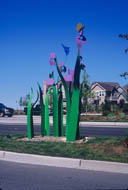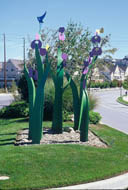Leon White remembers washing his sculpture of colorful steel flowers in the Issaquah Highlands last summer, when some joggers and cyclists stopped to thank him for brightening up their mornings with the piece.

“It was nice to have people actually notice it,” he said.
Residents’ positive reaction to the installation - called “Miracle Grow” - prompted the City Council this week to buy it for $18,000.
White’s work was part of Issaquah’s three-year-old Loaned Art Program, which borrows public art from local and regional artists and displays the pieces in various locations for one year. Artists receive $500 for transportation and installation costs. Six loaned pieces reside in Issaquah now.
The concept has gained in popularity over the years, with cities from Puyallup to Bellevue to Wenatchee creating their own programs. The mutually beneficial exchange gives cities a steady rotation of artwork for a minimal cost, while artists get exposure.
“Art adds talking points in a city,” said Susan Coombes, Issaquah arts commissioner. “It contributes greatly to the character of a city and increases community
pride.” It also draws tourists. And with tourists come dollars.
“It’s all about attracting people to your community,” said Kris Bassett, Wenatchee Arts Commission staffer. “Maybe they say, ‘Let’s go see the art in Wenatchee.’ Well, they have to eat. Then they might shop. So I see it as a whole big picture.”
The city of Bellevue has been exhibiting sculptures at its Downtown Park since 1992. The display of borrowed art runs from mid-June through October. Redmond relies on loaned art for its outdoor sculpture garden at Redmond Town Center, as does part of Puyallup’s Outdoor Gallery collection
In deciding which pieces make the cut, arts commis-sioners generally look for work that is durable and aesthe-tically exciting, staying away from religious or obscenity-laced themes. The importance of sturdiness in the artwork cannot be emphasized enough, said Mary Pat Byrne, arts specialist for Bellevue.
“People love to get their arms around the art,” she said. “If it’s at all climbable, we want to make sure that it’s strong enough to stand up to this tough love.”
Lending also provides a chance for artists to sell their work either to cities or individuals - although there are no guarantees. “We don’t ever promise the artist that we’ll buy,” said Byrne.
Sometimes a piece will be so powerful that people will stop, stare or even tear up, she said. She remembered one from 2002, called the “Wall of Masks,” that elicited such emotion. The work was done by Bellevue teenagers who created self-portraits in the form of masks. One was of a weeping angel’s head and wings; another was made of barbed wire.

Of course, not all artwork invokes awe. Some can be remembered just as vividly for drawing jeers.
Probably the most infamous loaned art in Issaquah was a 5-foot, 10-inch blue steel circle with three holes in it that used to sit across from the Village Theatre. Named “What Icarus Saw,” it soon earned the moniker “The Blue Blob.”
People “don’t always like every piece that we put out, but at least it gets them talking about art,” Coombes said.
White, 52, said he likes to throw in a bit of humor, hence the pun in the title of his “Miracle Grow” piece.
“It’s kind of like, hey, someone threw some Miracle-Gro on this and look what happened,” he said.
It’s not imperative all art carry some kind of a deeper meaning, said Coombes. The “Miracle Grow” piece, she said, is one such example.
“It offered such a welcoming sight and it makes you smile when you drive by it,” she said.
Copyright © 2006 The Seattle Times.
Used with permission

